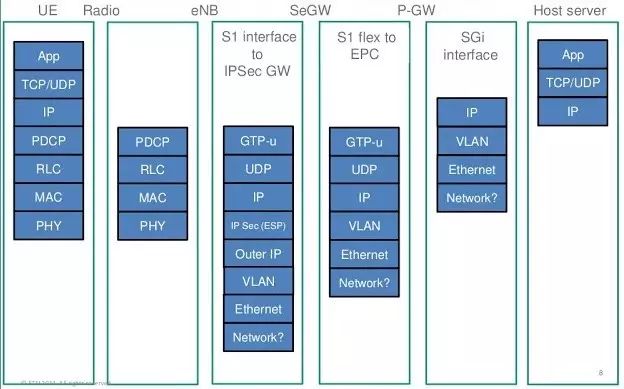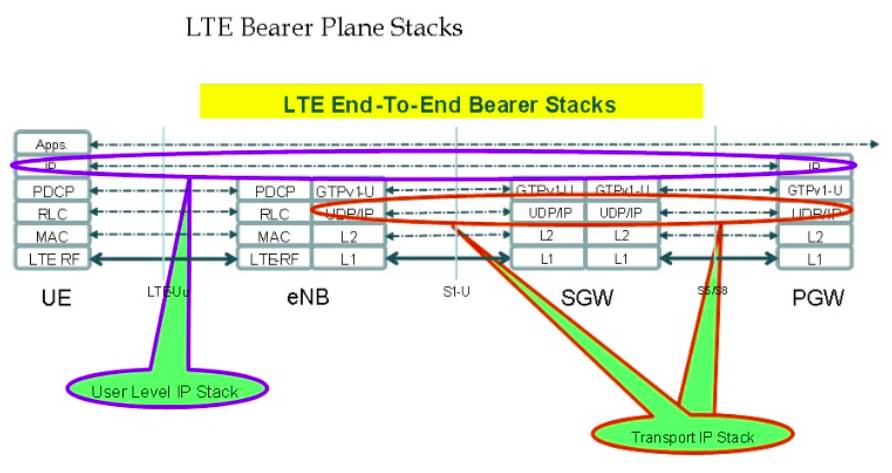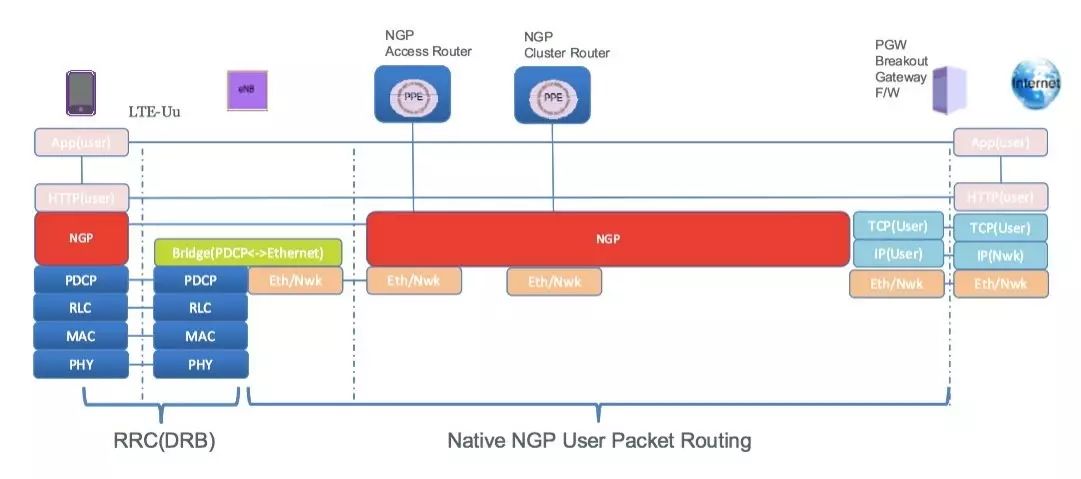I just don’t love you anymore.
This song that I have been looping for a week now sounds like 5G singing to TCP/IP.
As we all know, 4G LTE is fully IP-based, with upper-layer transmission using the TCP/IP protocol (as shown in the figure below).

▲LTE User Plane Protocol Architecture
However, this familiar architecture has not fully realized the potential of mobile networks and may even hinder future network development.
1
TCP/IP Restricts Mobile Internet
About a year ago, I heard an expert complain that TCP/IP was a mistake from the start…
The Internet and TCP/IP are complex products of politics, economics, society, and technology, driven by numerous motivations that cannot be explained by technology alone. They crush the “closed” telecom empires under the banner of “openness,” which is unfair and incorrect.
Why does TCP/IP have such an advantage? The network world is fundamentally a product of trial and error, and TCP/IP is no exception. However, TCP/IP rules the network era with an authoritarian posture, which may lead us to make more mistakes in the future.
Undoubtedly, since its invention in the 1970s, the TCP/IP protocol has connected countless computers and propelled the Internet’s rapid growth.
However, the original intention of the Internet was to design for fixed networks and network interconnection, and today we have entered the era of mobile interconnection. Looking ahead, 5G will face various applications such as AR/VR, ultra-high-definition video, IoT, and V2X, with diverse use cases. Coupled with the increasing urgency of network security, the TCP/IP protocol suite is difficult to adapt to the future; we need to redefine new protocols.
2
The Mistakes We Made Over the Years
Indeed, both 3GPP and IETF are great standardization organizations.
3GPP has changed the world with its unprecedented cellular mobile networks, enabling global roaming and ubiquitous mobile connectivity, bringing a vibrant mobile life to humanity. GSM is the greatest mobile voice communication network to date, while GPRS, UMTS, and LTE have ushered us into the mobile Internet era. Mobile networks have become as essential to daily life as water and electricity.
IETF has also provided network protocols for mobile networks, including TCP/IP, SCTP/DIAMETER (for LTE S1 access and core network signaling), and SIP (for VoLTE).
It can be said that the combination and complementarity of the two have propelled the prosperous mobile Internet era.
However, this combination is somewhat “forced.” The Internet was designed for fixed networks and interconnection, while 3GPP was born for mobile connectivity; the Internet’s connection is distributed, while mobile communication networks are centrally controlled. The genetic differences between the two inevitably lead to issues such as network inefficiency and high costs.
To explain this problem in detail, we need to start with the protocol architecture of 3GPP LTE.
For the user plane,

LTE continues the GPRS and UMTS architecture, adopting an IP-based communication protocol—the GTP tunneling protocol. It establishes end-to-end direct GTP tunnels, with user IP transmitted from the terminal (UE) to the core network (PGW) through the GTP-carrying tunnel. In this architecture, the access network is ignored, with no user-level routing choices, no content-aware capabilities, and no inherent user plane security mechanisms. Even every mobility migration must update the GTP tunnel.
This end-to-end user plane architecture requires many protocols to layer “bridge” the connections, encapsulating and decapsulating the GTP tunnel, IPSec encryption, ROHC compression, etc. This undoubtedly increases transmission delays and processing costs.
For the control plane,

GTP-C is the signaling control protocol, and EPC carrying requires a separate GTP-C control protocol. Only after the signaling for the EPC control plane is completed can IP packets be transmitted between the mobile network and the external Internet.
This method of establishing the bearer from the control plane to the user plane also increases transmission delays and processing costs.
Thus, we have been making mistakes.
From GPRS and UMTS to LTE, in order to enhance wireless rates, we have invested heavily in the wireless access part, yet we have made no progress in the protocol architecture. As part of the end-to-end ecosystem of mobile interconnection, we need more efficient mobile networks that allow every part of the network to perform its due role.
This inefficient GTP&IP combination wastes our wireless investments and urgently needs a redefinition of new protocols.
There are also security issues.
3
Security First
The current mobile Internet does not have a network access security mechanism based on the user itself.
SSL, TLS, and HTTPS are all one-size-fits-all end-to-end encryption methods that add overhead to all data packets and cover various applications and services.
However, in the 5G era, users will be more discerning, and applications will become increasingly diverse. Online payments, IoT, V2X… different application scenarios have varying security requirements, with some needing app-level security and others requiring network-level security.
Users have higher security demands, and all security must be considered at the user level, rather than through a unified security mechanism. As operators, we must keep a close eye on user security issues in real-time. The problem arises: if there is no user-level security management mechanism at the network user access level, we will inevitably expend a lot of human and material resources to ensure user security, which increases network OPEX.
Therefore, we need more flexible, future-oriented security mechanisms, such as user-plane access authentication, to replace control-plane user authentication.
In summary, the current protocol architecture of mobile networks restricts development, and 5G is our last chance; otherwise, we may have to wait another 10 years.
If we do not improve the protocol architecture from base stations to the Internet, the traditional inefficient GTP&IP will inevitably waste more of our wireless investments, and the performance, security, mobility, and scalability of the network will be constrained, further affecting operators’ ability to expand into new businesses like AR/VR and IoT and explore vertical market sectors.
It is time for change.
Thus, major organizations have proposed the Next Generation Protocol (NGP) initiative, including the European Telecommunications Standards Institute (ETSI) and the Internet Engineering Task Force (IETF), to replace TCP/IP.
Perhaps the protocol architecture for future 5G will look like this…

That song is playing again…
I just don’t love you anymore.
I don’t love you.
Not loving you anymore.
Never loving you again.
Network optimization freelance submission email: [email protected]
Long press the QR code to follow

On the road of communication, let’s walk together!